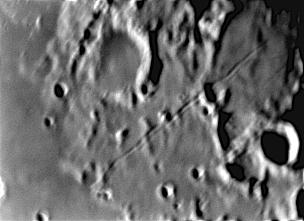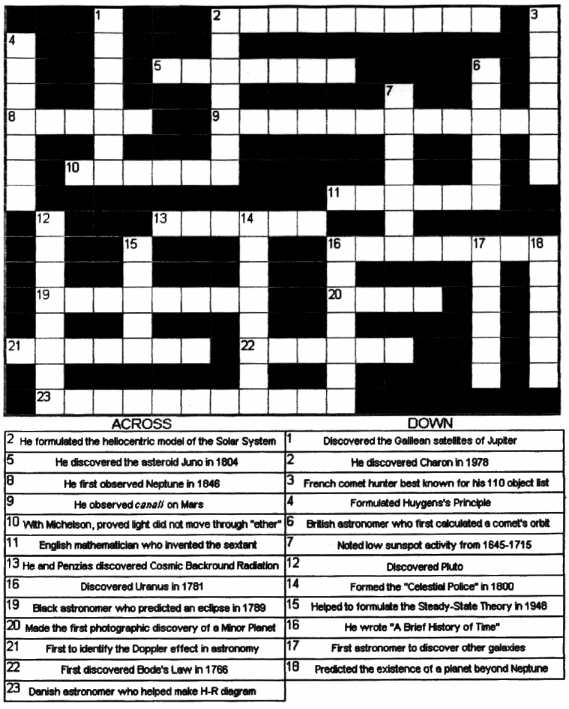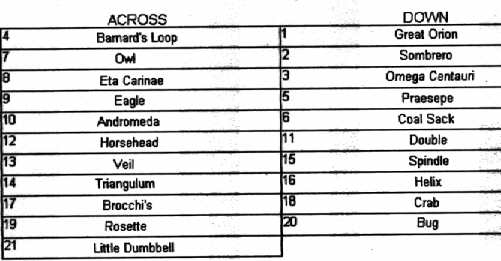

OAS Executive Committee
President- Dave Dunn, Ph. (801) 544-7705
Vice Pres- Lee Priest, Ph. (801) 479-5803
Secretary- Bob Tillotson, Ph. (801) 773-8106
Treasurer- Doug Say, (801) 731-7324
Vol. 30 Number 4 January 2001 http://physics.weber.edu/oas/oas.html
January's Meeting
The first monthly meeting of the Ogden Astronomical Society for the new year, century and millennium will be held at 7:30 p.m. this Thursday January 11, 2001 in the Ott Planetarium on the Weber State University campus. The recent interest and discoveries relating to an unknown force which appears to be accelerating the expansion of the universe will be discussed. The program will include a new PBS presentation entitled "Runaway Universe."
The year's star party activities for 2001 have
been finalized and the schedule is provided below. Not
listed here are numerous private parties which will be
organized by members and will be announced on a
monthly basis at the regular meetings.
March 23 - 24, - Messier Marathon & Star Party
Saturday April 28, - Antelope Island
Saturday May 26, - Antelope Island
Saturday June 16, - Antelope Island
June 23 - 24, Lowell Observatory, Arizona
July 20 - 21, overnight Monte Cristo
Saturday July 28, - Antelope Island
August 17 - 18, overnight Monte Cristo
Saturday August 25, - Powder Ridge at Powder Mtn.
Saturday September 22, - Antelope Island
Saturday October 20, - Antelope Island
November 16 - 17, Golden Spike; Leonids
For questions and additional information contact one of your executive committee members.
Minutes
Ogden Astronomical Society
December 14, 2000
Club president Dave Dunn called the meeting to order at 7:35 p.m.
V.P. Lee Priest and Dave recently attended a joint meeting with the Salt Lake Astronomical Society (SLAS) executive board for the purpose of coordinating some astro-activities between OAS and SLAS in 2001. One of these will be a trip to the Lowell Observatory in Flagstaff, Arizona in June. SLAS may have some of their members join OAS at Monte Cristo in July and August. Another Swap Meet and Sun Party at a local Harmon's may be planned.
The 2001 star party schedule will be published in the next Star Diagonal.
Bob Tillotson shared the recent mail received by the club with the members. The materials are there to be taken by the members.
The meeting's 'Show and Tell' was opened by Dave Dunn. Others displaying astro-stuff were Wayne Sumner, Jim Seargeant and Steve Richer.
Of special interest was Jeremy Mathews' announcement that he has been selected, from among hundreds of applicants, to attend astronomy "Youth Camp" this summer. Jeremy described the efforts required to be considered for this accomplishment. Congratulations and hand shakes all around.
The meeting adjourned to the usual rap session at 8:35 p.m.
Bob Tillotson, Secretary
At 4:00 the first of the participants showed up, Dave Dunn with his arsenal of viewing devices. The ever present 4" equatorial and all of it's accessories like the auto-drive and battery to power it up. A 10" Newt, on a Dob. Mount. And lastly the latest special from the optical world, a pair of "Bear" 15X70 binoculars from The Sportsman's Guide. I told Dave to go ahead and to setup in the backyard, I walked him around the side of the house and showed him where I had plowed the remaining snow off the grass so that we wouldn't need any ground coverings. There is a massive "T" cleared in my back yard now along with several car tracks, which were placed there later that night. Dave immediately started to set his equipment up and I returned to the house because I was still on Dad patrol.
I set up a refreshment center at the middle of the T (couple of wooden work horses with a 3/4 " piece of plywood for a table to hold a 5 gallon Gott water tank filled with hot water). Nothing but the best from a amateur telescope maker and then set up hot chocolate and apple cider mix. This I hoped would stave off the chills that I knew was going to come later that night.
I got my 16" Meade out of the shed and placed it on my trusty "Radio Flyer" and hauled it by hand out back and set it up with the help of my 10 year old daughter. She gets so excited when I set up the scope. Then she try's to show off how much she knows of astronomy. Then she started getting interested in Dave's equipment. Then as kids are, she took off to play in the piled up snow.
Before long, the sun was gone and the skies were starting to loose the light and I could just barely make out the cars passing in front of the house, Lee Priest pulled in with BOB in tow. I walked up to meet him and told him to go ahead and just pull into the backyard. Which he did and we (Dave, Lee and I) set BOB up in the intersection of the T.
The sky was getting a dirt gray film across it and I still had my doubts as to what we might be able to see, I really thought that this might turn into another "Harmons event". You know pick up the brightest objects in the sky and stay with it all night long. Don't get me wrong I like Harmons and the star parities but, I like a lot of variety also. My backyard is fairly deep and wide and I live in a place that is darker than your normal neighborhood areas but, the sky just might make it difficult.
With BOB set up, Dave's three and my Meade all we had to do now was wait. About 20 minutes after Lee showed up the first of our quarry appeared. Saturn and Jupiter appeared just in the top of the cherry tree on the northeast edge of my property, but the scopes would be able to see through the limbs and actually make the viewing a touch better. The sky was still giving us a thick haze to bore through and the images were not that great. But, we did get to see all four of the moons around Jupiter and the rings of Saturn were just barely discernible.
To the west the sky was giving up the last vestiges of light when Dave turned the 10" towards M57 and started to stalk the usual haunts I did the same waiting for more elusive prey when my neighbor, Jay, came walking up and we started showing the evening fare to him. Jay has coated several mirrors for members and non-members in the area. He was very taken with Saturn and the intermittent hazing from the clouds didn't seem to bother him too much.
Gary Liptrot showed up around 6:30 or so. I had called him earlier to see if he was coming out. A few days before, he told me he would so I called to confirm. As I walked back out to the backyard I looked up and all I could see was clouds!. Totally bummed out, I walked back into the yard and expressed my opinion. Dave said that normally, it rains when we set up these special events and I remembered he was right. I recalled the open house last year at Weber we had set aside two dates just in case of bad weather and sure enough, we got skunked on both occasions. Oh sure, the weather in between was fine. Just the days we wanted to use our stuff, Bam! have some rain. ( I digress, sorry). Anyway, while I was showing my neighbor M57 Gary was getting eyefuls of Jupiter and it looked like Ganymede was just getting on the edge of Jupiter.
All during the first part of the night we were watching Ganymede make it's way ever so slowly toward the top quarter of the Jovian behemoth. As we watched ,Dave brought a light blue filter and I put it on my standard 25 mm Meade eyepiece and turned my attention back to Jupiter. The detail jumped out! The bands were so much clearer and defined.
Dave then pulled the 10" to the Dumbbell and put his nebula filter and targeted it, really made it stand out. All of this time we didn't realize how clear the sky was getting.
All of a sudden Gary and Lee started talking real excited like and we (Dave and I) stopped and asked what's up and they said that it looked like Ganymede was going to transit. I immediately went back to my scope and set back up on Jupiter. I changed my eyepiece to a 10.5 orthoscopic and put the blue filter on and what a sight that was! The red spot was visible in the southern equatorial band. The swirl around the spot was just barely perceptible, but, the real unexpected treat was the black eye that was being generated by the shadow of Ganymede on the cloud tops of Jupiter!.
Ganymede was positioned so that the shadow was very visible but, what was really cool was the contrast and closeness to the orb. We could still see Ganymede and the shadow! I was stoked! Just about at that time my brother and his girlfriend showed up. They were also pleasantly surprised with the clarity of BOB and the others. My brother was impressed by being able to see a shadow of a moon on the parent planet. For the rest of the evening I watched the progression of Ganymede as it slowly crossed the top quarter of the Jovian giant then when the shadow left the surface so did Ganymede. Or so it appeared.
All in all it was a great party. My wife even made the trip out with my three year old in tow. She even got a little excited because she had never seen Saturn or Jupiter with that much detail. Who knows I might be able to get her more interested too?
The party called it an end when what appeared to be a continuous cloud bank finally shutout the last of the stars. So we disassembled the scopes I left mine till last. We got BOB reloaded back on the trailer, Dave pulled his Blazer into the backyard; loaded up and left. Just as Lee was about to leave, the skies opened again clearer than ever. The weather gods played with us all night and now tempted us again. Well, it was closer to 10:00 or after. We had several hours of viewing. And it was COLD. We packed my equipment and refreshment center into the back of a truck and drove to the front and put it away.
I told Dave before he left, that Paulette (my brothers girlfriend) lives in West Warren, waaaaay out there and she has an excellent place for a evening party and that she agreed to hold one there if we wanted. So who knows? Maybe January?
Lunar Features

Views of our moon are dominated by round features such as mares and craters, so the valleys and scarps really catch the eye. On 2 December I was touring the moon at high magnification and came across this interesting feature. It appears to be a fairly straight valley with either a slumped south rim or a wide floor. To the south of the north end of the valley, two similar but smaller features can be seen. Another interesting feature is located near the north edge of this image, about 1/3 of the way in from the left edge. It appears to be a crater formed by an object sticking the moon at a shallow angle or by a closely spaced string of impacts.
This image taught me something about imaging the moon. At the time I took the pictures, I assumed that I would be easily able to identify the features on one of the many available lunar maps. Wrong! Since I was shooting at f/20, the images are only 2.6 x 3.9 arc-sec; with this small area, it has proven difficult to locate this area on a lunar map. Even after eliminating the part of the moon in shadow on 2 Dec and confining the search to the middle areas (the craters are seen from almost overhead, eliminating the areas toward the edge of the moon) I have not been able to locate these features. Nest time, I will carefully note the region of the moon that I'm shooting!
This imaging session was an experiment is shooting at f/20 using a Televue Big Barlow in front of the ST7 and it has just about convinced me to stick at f/10 or f/6.3. The higher magnification magnifies all of the problems in imaging - mount vibrations, atmospheric turbulence (out of ten shots of this area, only one was really sharp), optical aberrations, etc. It appears that staying with f/10 as my high magnification limit and simply using the ST7 at high resolution to gain higher resolution will produce better results.
This image was calibrated by subtracting bias and dark frames - a flat was not available. Both unsharp mask and sharpening filters were applied to the point where artifacts are visible at moderate magnification, but this did make the details more distinct.
If anyone can identify these lunar features for me, I'd be most grateful.
Jim Seargeant
Crossword Challenge
by Jeremy Mathews
- Astronomers -

Answers to Last Month's
Crossword Challenge
"Object Names"
